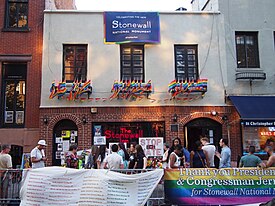
Back سياحة المثليين Arabic Twristiaeth hoyw Welsh LGBT-Tourismus German Turizmê LGBTy DIQ Turismo LGBT Spanish Tourisme gay French תיירות גאה HE Turismo LGBT Italian LGBTツーリズム Japanese LGBT 관광 Korean

| Part of a series on |
| LGBTQ topics |
|---|
|
|
LGBTQ tourism (or gay tourism) is a form of tourism marketed to gay, lesbian, bisexual, transgender and queer (LGBTQ) people.[4] People might be open about their sexual orientation and gender identity at times, but less so in areas known for violence against LGBTQ people.[5][6]
The main components of LGBTQ tourism include: destinations, accommodations, and travel services wishing to attract LGBTQ tourists; people looking to travel to LGBTQ-friendly destinations; people wanting to travel with other LGBTQ people when traveling regardless of the destination; and LGBTQ travelers who are mainly concerned with cultural and safety issues.[7] The slang term gaycation has come to imply a version of a vacation that includes a pronounced aspect of LGBTQ culture, either in the journey or destination.[8] The LGBTQ tourism industry includes destinations (tourism offices and CVBs), travel agents, accommodations and hotel groups, tour companies, cruise lines, and travel advertising and promotions companies who market these destinations to the gay community.[7] Coinciding with the increased visibility of LGBTQ people raising children in the 1990s, an increase in family-friendly LGBTQ tourism has emerged in the 2000s, for instance R Family Vacations which includes activities and entertainment geared towards couples including same-sex weddings. R Family's first cruise was held aboard Norwegian Cruise Lines's Norwegian Dawn with 1600 passengers including 600 children.[9][10]
Major companies in the travel industry have become aware of the substantial money (also known as the "pink money") generated by this marketing niche and have made it a point to align themselves with the gay community and gay tourism campaigns.[11] According to a 2000 Travel University report, 10% of international tourists were gays and lesbians, accounting for more than 70 million arrivals worldwide.[12] This market segment is expected to continue to grow as a result of ongoing acceptance of LGBTQ people and changing attitudes towards sexual and gender minorities.[7] Outside larger companies, LGBTQ tourists are offered other traditional tourism tools, such as networks of LGBTQ individuals who offer each other hospitality during their travels and even home swaps where people live in each other's homes.[13] Also, available worldwide are social groups for resident and visiting gay, lesbian, bisexual, and transgender expatriates and friends.[14]
- ^ Goicichea, Julia (August 16, 2017). "Why New York City Is a Major Destination for LGBT Travelers". The Culture Trip. Archived from the original on January 2, 2020. Retrieved February 2, 2019.
- ^ Rosenberg, Eli (June 24, 2016). "Stonewall Inn Named National Monument, a First for the Gay Rights Movement". The New York Times. Archived from the original on May 6, 2020. Retrieved June 25, 2016.
- ^ "Workforce Diversity The Stonewall Inn, National Historic Landmark National Register Number: 99000562". National Park Service, U.S. Department of the Interior. Archived from the original on March 6, 2016. Retrieved April 21, 2016.
- ^ Greenberg, Peter (2007). The Complete Travel Detective Bible: The Consummate Insider Tells You What You Need to Know in an Increasingly Complex World. Rodale. ISBN 9781594867088. Preview. Archived 2016-05-01 at the Wayback Machine
- ^ Friskopp, Annette; Silverstein, Sharon (1996). Straight Jobs Gay Lives: Gay and Lesbian Professionals, the Harvard Business School, and the American Workplace. Simon and Schuster. ISBN 9780684824130. Preview. Archived 2016-04-24 at the Wayback Machine
- ^ Wieder, Judy (14 April 2004). "Shipping Out, Olivia Style on the Mexican Riviera: Olivia Cruises is everything people say it is, and absolutely nothing like it". outtraveler.com. Out Traveller. Archived from the original on 2 February 2020. Retrieved 1 February 2016.
- ^ a b c Guaracino, Jeff (2007). Gay and lesbian tourism: the essential guide for marketing. Butterworth-Heinemann. ISBN 9780750682329. Preview. Archived 2015-09-10 at the Wayback Machine
- ^ Baughman, James Keir (2003). Villages by an Emerald Sea: America's New Rivera, Northwest Florida's magnificent emerald coast. Baughman Literary Group. ISBN 9780979044304. Preview. Archived 2015-09-19 at the Wayback Machine
- ^ "Q and A with Rosie and Kelli on "All Aboard! Rosie's Family Cruise"". Planet Out. 2006. Archived from the original on 26 May 2006. Retrieved 21 June 2007.
- ^ Davis, Andrew (12 January 2005). "Getting Away with R Family Vacations". Windy City Times. Archived from the original on 2 April 2019. Retrieved 21 June 2007.
- ^ Danuta Walters, Suzanna (2003). All the rage: the story of gay visibility in America. Chicago: University of Chicago Press. ISBN 9780226872322. Preview. Archived 2015-09-10 at the Wayback Machine
- ^ "Travel University Report: Specialty Travel – Gay". travel-university.org. Travel University. Archived from the original on 2012-05-05. Retrieved 2012-04-01.
- ^ Home Sweet Swap: Who needs a hotel when you can trade your own abode for a fab flat? Welcome to the world of gay home exchange networks Archived 2009-01-14 at the Wayback Machine by Lauren Ragland; Out Traveler – Spring 2006.
- ^ Chesnut, Mark (2002). The gay vacation guide: the best trips and how to plan them. Kensington Books. ISBN 9780758202666. Preview. Archived 2015-09-19 at the Wayback Machine